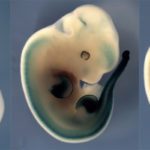Link to Pubmed [PMID] – 19266017
PLoS Genet. 2009 Mar;5(3):e1000398
During development of the vertebrate body axis, Hox genes are transcribed sequentially, in both time and space, following their relative positions within their genomic clusters. Analyses of animal genomes support the idea that Hox gene clustering is essential for coordinating the various times of gene activations. However, the eventual collinear ordering of the gene specific transcript domains in space does not always require genomic clustering. We analyzed these complex regulatory relationships by using mutant alleles at the mouse HoxD locus, including one that splits the cluster into two pieces. We show that both positive and negative regulatory influences, located on either side of the cluster, control an early phase of collinear expression in the trunk. Interestingly, this early phase does not systematically impact upon the subsequent expression patterns along the main body axis, indicating that the mechanism underlying temporal collinearity is distinct from those acting during the second phase. We discuss the potential functions and evolutionary origins of these mechanisms, as well as their relationship with similar processes at work during limb development.

